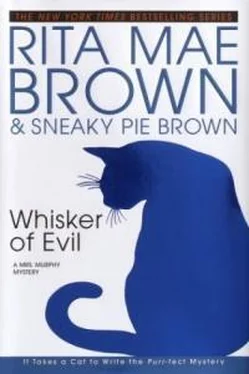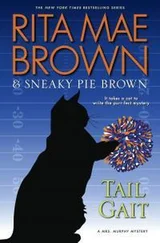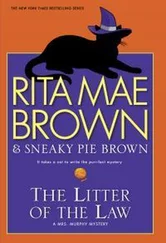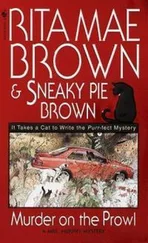“It’s so clean it almost seems premeditated.” Little Mim, intelligent like all the Urquhart clan, pursed her lips.
“By an animal?” Blair handed Harry his kerchief, since she hadn’t removed all the dirt.
“The human animal,” Mrs. Murphy quietly said.
11

A pair of brilliant turquoise eyes peered out of the passenger side of the car. Sissi, a gray tuxedo cat, was irritated that her human, Rose Marie Dunlap, was chatting at the gas pump at the Amoco station.
Sissi accompanied the always well-turned-out Rose Marie on her regular trips from Washington, D. C., to Crozet. She enjoyed riding in the car but she enjoyed arriving at their destination even more, the farm of Rose Marie’s daughter, Beth Marcus.
“I haven’t seen you in ages.” Rose Marie smiled.
“You know it’s been years since I’ve been back here.” Marshall Kressenberg, florid, bent over to shake her hand. “I was coming back from Lexington, Kentucky, and thought I’d stop by to see some of my old running buddies. Course, I should have called first. Everyone’s out and about.” He accented “out and about” the Virginia way, which also sounds Canadian. “You’re looking well.”
And indeed, Rose Marie Dunlap’s appearance—petite, fresh, and healthy—belied her eighty-six years.
“I keep busy. For one thing, Sissi keeps me busy.”
At the sound of her name Sissi meowed, “Let’s go to Beth’s now!”
Marshall laughed as the cat continued to jabber. “Well, I’m so glad to see you.” He opened the door to his truck.
“I read your name in the sports pages. I’m glad you’ve done so well.”
He closed the door, window down. “It’s a good thing the horses are running and not me. I wouldn’t make it to the first pole.” He laughed, cut on the motor, and drove off.
“ We can go now ,” Sissi grumbled.
Rose Marie slid behind the wheel. “You can be so impatient.”
Marshall switched on his cell phone, dialing Big Mim’s barn number. Big Mim had a good breeding program, good but small. He wouldn’t mind seeing what she had before the sales. The barn recording came on. He disconnected and headed out toward I-64. Tavener could tell him what Mim had on the ground. Maybe it was just as well no one was around. He’d get pulled into long conversations, and he needed to get back to Maryland.
Too much going on in the horse world right now.
12

A sample of Barry Monteith’s brain tissues rested under the fluorescence microscope.
The gang at the lab examined a variety of Barry’s tissue samples. Given the odd circumstances of Barry’s death, a variety of tests had been ordered by the Albemarle County coroner, Tom Yancy, at Sheriff Shaw’s request.
Georgette Renfrow, one of the best of the bunch, peered intently through the lens. She was performing a direct fluorescent antibody test, shortened to dFA. Round dots of varying size, a bright fluorescent apple-green color, jumped right out at her.
“Jesus.” She whistled.
In all her years at the lab, Georgette had only seen this once before, and that was in the brain tissue of a prisoner who worked the road gangs and died mysteriously. The prison physician couldn’t detect the cause of his intense suffering.
“Jake, take a look.” She motioned for a twenty-seven-year-old assistant to look.
He came over, bending to put the eyepiece at just the right place. “I’ve never seen that.”
“Remember it.”
“What is it? I suppose I should know, but I don’t think I’ve seen it and I don’t remember it from school.”
She peered into the microscope one more time, then tapped her index finger on the smooth desktop. “Rabies.”
13

T hat’s bizzare,” Harry exclaimed when Cooper told her the report on Barry Monteith. The deputy also told her everyone who had contact with the body needed to get tested for rabies. She’d gotten Harry an appointment with Bill Langston, her family doctor, at eight the next morning.
Harry and Fair were in Miranda’s garden when Cooper arrived, putting together a gazebo as promised. Tracy Raz, Miranda’s high-school beau, was down in Charlotte, North Carolina, on business or he would have put his shoulder to the wheel, too.
Having chased one another to exhaustion, the animals had plopped under Miranda’s sumptuous roses, which were every color imaginable. Pewter preferred the peach, a thin red outline tracing each petal. Mrs. Murphy dozed under pure white roses, while Tucker snored under hot coral. They awoke when Cooper walked up the hand-laid brick walkway this late Friday afternoon.
“Wouldn’t we have known? Wouldn’t he have been foaming at the mouth when Harry found him?” Miranda, shocked at the news, asked.
“Not necessarily.” Fair knew a great deal about rabies. “Once the virus is in your nervous tissue it can take one to three months to present itself, for the victim to show clinical signs of infection,” Fair said.
“Not in the blood?” Miranda asked.
Cooper, who had grilled Dr. Hayden McIntire the second the report came over her computer screen, said, “No. Rabies is only in nervous tissue. It’s not going to show up in blood samples. Ideally you want brain tissue, which, of course, you can’t get from a living victim. In Barry’s case, we had samples.”
“You suspected rabies?” Harry inquired.
“No. But given the manner in which he was found and that the cause of death might be an attack from a wild animal, Rick and Yancy of course asked for rabies tests.”
“So it’s not in the blood but it would show up if whatever killed him had infected him?” Harry asked.
“Rabies.” Tucker’s ears pricked right up, as did the two kitties’ ears.
“That depends,” Fair said, his voice reassuring just because it was so deep. “Rabies is in saliva. A human is bitten and the virus replicates fairly rapidly, but it has to travel to the brain. Actually, this disease is quite unique and terrifying, really. It’s a bullet virus. It gets into the nerve tissue, and when it finally gets to the brain, you see the typical signs of rabies. Like I said, that usually takes between one and three months.”
“That long?” Miranda was surprised.
“That long, but if you’re bitten and you don’t get the series of shots within a week, there’s nothing that can be done. Rabies is always fatal.”
“Fair, how would you know—I mean, how would you know that the animal that bit you was rabid?” Cooper thought she knew the answer but wanted to hear his reply.
“You don’t. Let me back this up a minute. Usually the first person to identify rabies is a veterinarian or a hunter. Domestic animals like dogs, cats, and horses so rarely have rabies now that it’s noteworthy if they do. The public is educated about inoculating their pets and stock. When we see rabies it’s usually raccoons; that accounts for 40.6 percent of reported cases, with skunks coming in at around 29.4 percent.”
“How do you remember all that?” Miranda was impressed.
He smiled genially. “It’s my profession. How do you remember all your rose varieties? But the thing about rabies is, if someone is bitten by a raccoon or a skunk they know it.”
Читать дальше













